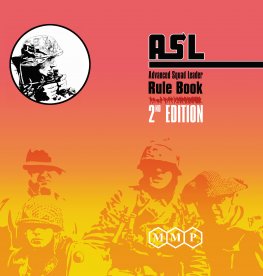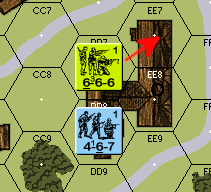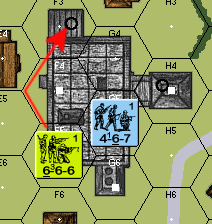
I first wrote about Control in this earlier article. Even as I wrote it, I was aware of some Q&A which were contrary to my understanding of the rules. I didn’t bring these up in that article because I didn’t want to confuse the issue. Even now, I hesitate to bring these up.
At ASLOk XXXVII, I spoke with Perry and several players and tournament directors about the issues I perceive. I won’t claim to speak for any of those people. I am also not claiming to speak for Perry or MMP. But one thing that became clear to me is I am seemingly in the minority on this. While most people acknowledge there is an issue, those that I spoke with see things as Perry does in this upcoming Q&A.
So I am going to bring this issue to the fore, show what I see as an issue, and let you decide for yourself. I think there are still some remaining issues and I believe there needs to be a clarification at some point.
Rules Dive

In this article we are examining A26.11. The rule says “a side gains Control of a Location/hex/building by occupying it with an armed Good Order Infantry MMC without the presence of an armed enemy ground unit … in that same Location/hex/building.” I have simplified the rule so it is more clear. The gist of the rule–particularly as it applied to buildings–is if one side occupies a building without the presence of an enemy unit in that building, the side solely occupying the building gains control. If this is confusing, I refer you to my earlier article.
The “Issue”
Contrast that rule above with the two Q&A noted in the footnotes below.12 Each of those Q&A arguably can have a unit leaving a building solely occupied by an enemy unit and still keep control.3 Below are some examples which show the conflict between the rules and the Q&A.
It is important to note I am not contesting Hex or Location control. I believe those are clear in the rules and not in question when considering these Q&A.
Example 1

This first example comes from board 23. Imagine the Americans have control of the building. As part of their MPh, the American unit moves from L7 to M8. In doing so, the American squad is subject to First Fire Movement in the Open (FFMO) at the vertex L7/M8/M7. The unit is clearly not in the M8 building. A pedantic reading of the rules suggests this movement transfers control of the building to the German unit. The Q&A state otherwise. If the American unit opted to bypass at the L7/L8/M8 vertex instead, the move would still incur FFMO penalties and be arguably outside the building.
Example 2

This next example comes from board 22. Again, the Americans control the building. The American squad moves from DD7 to EE7. This move offers a Snap Shot along the DD7//EE7 hexside. The TEM for this Snap Shot would be zero, not +2 Building TEM. This reduced TEM again suggests the 6-6-6 has momentarily left the building, leaving the 4-6-7 as the sole occupant. Per A26.11, control should pass to the Germans. The Q&A again says otherwise.
Reconciling the Q&A With The Rules

Sadly, I cannot reconcile the two. In speaking with people, they all note the moving unit has not left a building Location. This is correct but then leads to the situation at the right, also on board 22. Again, the Americans control the building. The American unit moves from F5 to F3, using a two hexside bypass via F4. Once again, the American unit NEVER leaves an H4 Building Location, but is clearly traversing Open Ground when moving via F4. If this is the intent of the Q&A, then the Q&A also allows this situation.
Perhaps a side does not lose control when moving from a building Location to an accessible, adjacent Location of the same building. Both Q&A depict this “move to adjacent hex” situation and offer the same answer.
Which of these two interpretations is meant by the Q&A is not particularly clear. Perhaps there is some still unsaid third option being described.
Why Is This Happening?
Row Houses have been around for a long time. I am not entirely sure why this question wasn’t asked before I did some years ago. There was a long discussion about this on social media, with people coming down on either side of the argument. More than a decade later, some opinions have changed from the original discussion and the Q&A remains in place.
But on the other issue, I think this is an outcome of more interesting artwork being created on more modern boards. Sure, board 22 has been around for a long time. But newer city boards and HASL maps are seeing more interesting building artwork creating more and more opportunities for these types of control questions to creep into play. IMO, the rules haven’t kept pace with the artwork. Admittedly, I am in the minority, at least among the people I spoke with at ASLOk.
Conclusion

I am not sure what is going to happen on this. I know Perry is aware of the issue and he stands by his Q&A. As players, we have to have some ultimate arbiter of the rules and that position falls to Perry.
I bring this up here for those who don’t follow the Q&A closely and who look at the rules as pedantically as I do. I am not sure how you get from the rules to the Q&A but Perry’s intent is clear and consistent, even while the implementation is murky outside these two examples. Still, the Q&A provide some clarity and if you’re reading this, now you know too.
A. No.
A: No.


Hmm. That really is a pedantic reading, though. LOL
I don’t think leaving a Building via a hexside or vertice should count.
Good article Jim. My two cents (which are worthless), you can argue example 1 that the building is still controlled by the American due to the unique nature of rowhouses in ASL, but in example 2 the controlling unit clearly leaves the building. If I was unaware of the Q and A, I would have played that control was lost when the squad moved from dd7 to ee7. Thanks for another enlightening article and it was great seeing you at Aslok
Have a look at footnote 3. A rowhouse is like any other building for purposes of building control. I anticipated that question.
I think there’s another question at play – strict parsing of the rules versus being a good sport. I would be embarrassed to claim that control had been forfeited by moving along a row house.
Strict parsing of the rules isn’t being a poor sport in my opinion. Good fences make good neighbors and the rules are the fences around our community is built. JMO, YMMV.
Example 2 does not have a separate movement expenditure outside. Examples 1 and 3 have one MF in bypass, outside. Example 2 has a stronger case for never expecting MF outside.
The best resolution is to add all the examples to the ASLRB and state retain or loss of control. In the modern age of the eASLRB, adding the examples is not that big of a deal
As simple way to fix this is in the end of the current player turn. IE) end of the CC/ CLEAN UP Phase, players check the victory building/ location and see what MMC are there. If the attacker for that turn is the only MMC counter remaining they control that building/location, same as the defender. If both sides occupy it then it is a contested location.
Doing it this way would mean you can’t “move through” a building to gain control and would be a significant change WRT balance. Like this, an MMC could only capture one building a turn. I would not be in favor of this. — jim
I don’t mind accepting the majority view. The game is very vague on time and what is going on during the notional two minutes of a turn. Literal interpretation isn’t possible. There has to be some stretch factor because we’re not playing 12-16 minute battles. My pet hate is any movie scene where you can see a section of soldiers all in shot at the same time. No, it never happened with experienced soldiers. They spread out and moved one or two at a time from cover to cover. So with stretchy time and stretchy sections I can accept some stretchy rules too.
could you include tje option dowload pdf, i normally download the articles to print, thanks for your work
Done. Mea culpa.